Are you worried that your museum lighting is slowly damaging priceless artifacts? The wrong light fades colors and degrades materials, but COB LED downlights offer a powerful, protective solution.
COB LED downlights provide precise beam control, superior color rendering (CRI), and minimal UV/IR radiation. This protects delicate exhibits from damage while ensuring the artwork looks vibrant and clear for every visitor, balancing preservation with presentation.
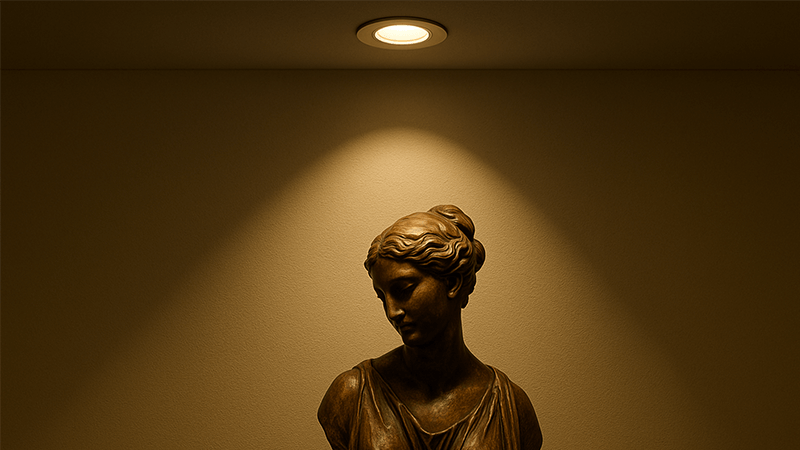
When I first started in the lighting industry, I saw many museums using old halogen lights. They produced beautiful light, but they were also slowly cooking the very art they were meant to display. Today, we have much better technology. The challenge is no longer just about making things bright; it's about lighting with intelligence and care1. For professionals like Shaz, who manage large-scale projects, understanding these details is crucial for success. In this article, I want to share my direct experience with COB LEDs and explain why they are the best choice for protecting and presenting cultural heritage2. We will explore how to select the right lighting and why this technology is a game-changer.
What is the best lighting for museums?
Choosing the wrong lights can ruin a priceless collection. Harsh, uncontrolled light causes irreversible damage over time. The solution is a layered lighting strategy3 using high-quality LED fixtures.
The best lighting for museums uses a layered approach with high CRI (90+) LED fixtures4. These fixtures must offer precise beam control5, produce zero harmful UV/IR radiation, and use an appropriate color temperature (2700K-3000K)6 to ensure both preservation and accurate presentation.
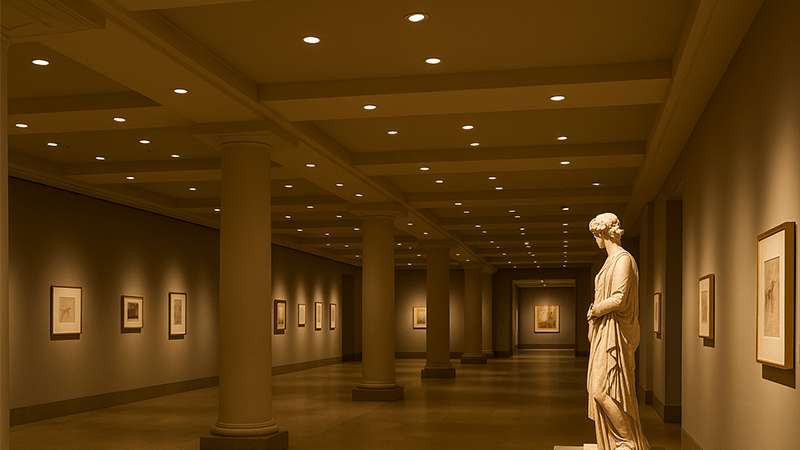
When we talk about museum lighting, we are balancing two important goals: protecting the exhibits and creating a great experience for visitors. A layered lighting plan is the best way to do this. It involves three main types of light. First is ambient light, which provides general, low-level illumination for safe navigation. Second is task lighting, used in specific areas like reading labels. The most important layer is accent lighting7, which is where COB LED downlights8 excel.
The key is precision. My main insight for museum lighting has always been about achieving "ultra-low illuminance9" protection through precise control. COB LEDs allow us to focus a sharp, clean beam of light directly onto an artifact. This makes the object appear bright and vibrant to the human eye. At the same time, because the light is so controlled, we can keep the surrounding area darker. This reduces the total amount of light energy hitting the sensitive exhibit over time, significantly slowing down degradation. It is a smart way to protect the art while making sure it looks its best. We are not just blasting light; we are sculpting with it.
Here is a breakdown of what to look for:
| Feature | Specification | Why It Matters for Museums |
|---|---|---|
| Color Rendering Index (CRI) | 90+ (ideally 95-97) | Shows the true, original colors of the artwork as the artist intended. |
| UV/IR Radiation | Zero | UV light fades pigments, and IR light (heat) damages organic materials. LEDs naturally produce very little of either. |
| Color Temperature (CCT) | 2700K - 3000K | Creates a warm, inviting atmosphere suitable for historical artifacts. It avoids a cold, clinical feel. |
| Beam Control | Interchangeable optics, snoots, louvers | Allows you to shape the light beam precisely to fit each exhibit perfectly, minimizing light spill and protecting sensitive items. |
What are the pros and cons of COB LED strips?
You need continuous light for certain displays, but many options create distracting hotspots. COB LED strips10 provide a seamless line of light11, but they have specific uses and limitations.
COB LED strips offer perfectly uniform, dot-free illumination, ideal for cove lighting, backlighting, or display cases. However, their wide, uncontrollable beam angle makes them unsuitable for accenting individual artworks, where focused COB downlights perform much better.
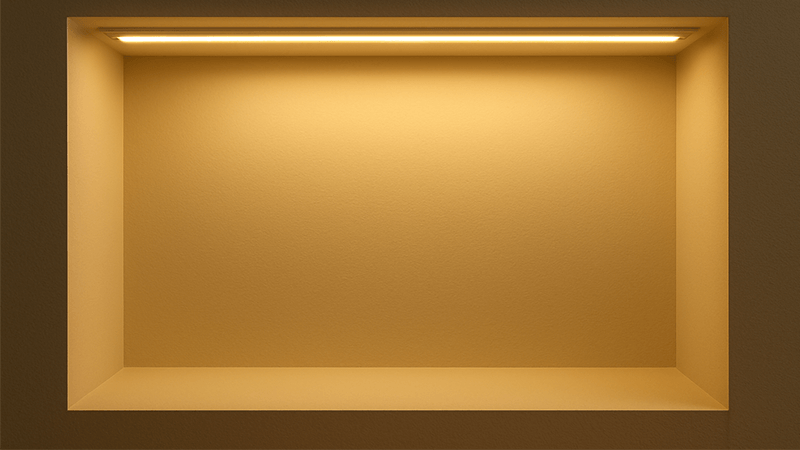
COB LED strips are a fantastic technology, and I use them in many projects. They solve a common problem with older LED strips, which had visible dots of light. Because a COB strip packs the LED chips so closely together, it produces a single, smooth line of light. This is perfect for architectural details, like lighting a cove in a ceiling or running a continuous line of light under a shelf. In a museum, they are excellent for illuminating the inside of a display case evenly, creating a beautiful glow without any distracting hot spots.
However, it is very important to use the right tool for the job. The greatest strength of a COB strip is also its main weakness for accent lighting. A strip is designed to cast light over a wide area. It is a floodlight, not a spotlight. You cannot focus a strip's light onto a single small sculpture from the ceiling. Trying to do so would spill a huge amount of light everywhere, washing out the drama and failing to protect the piece. This is where I have to guide my clients, like Shaz, to make the right choice. While strips are great for ambient or integrated lighting, they cannot provide the precise control needed for accenting.
Here is a simple comparison for a museum setting:
| Application | COB LED Strip | COB LED Downlight/Track Light |
|---|---|---|
| Highlighting a Painting | Poor | Excellent (precise beam control) |
| General Room Ambience | Good (in coves) | Good (with wide beam angles) |
| Inside a Display Case | Excellent | Poor (creates hotspots) |
| Architectural Details | Excellent | Not suitable |
| Flexibility for Changing Exhibits | Poor (fixed installation) | Excellent (track lights can be moved) |
For accenting art, you need a fixture that can act like a sniper, not a shotgun. That is the job of a COB downlight or track light.
What is the best lighting for an art gallery?
Art gallery lighting must be both accurate and highly flexible. Poor lighting can misrepresent the artist's work, which can directly impact sales and the gallery's reputation.
The best lighting for an art gallery is a flexible track lighting system12 using high CRI (95+) COB LED spotlights. This setup allows for easy repositioning and precise aiming as exhibits change, ensuring every piece is rendered in its true, vibrant colors.
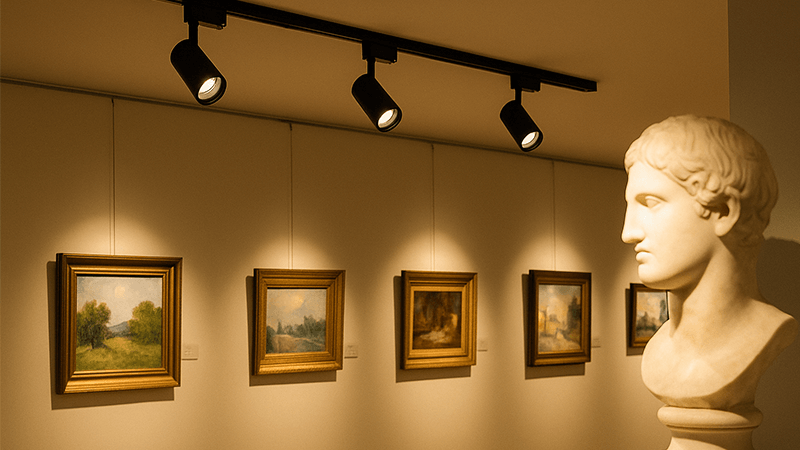
An art gallery has different needs than a museum. While preservation is still important, the primary goal of a gallery is to sell art. This means the lighting must be perfect to make the art look as compelling as possible. It also has to be incredibly flexible, because exhibitions can change every month. For this reason, my number one recommendation for any gallery owner is always a track lighting system. This allows you to move, aim, and change light fixtures without calling an electrician.
Within that track system, COB LED spotlights13 are the ideal choice. The technology's compact, intense light source is perfect for creating the dramatic "punch" that makes a piece of art stand out. The CRI must be as high as possible, preferably 95 or even higher, to show the subtle nuances in an artist's color palette. I worked with a gallery owner in Dubai who was using old lighting, and his colorful paintings looked dull. We switched him to a 97 CRI COB LED track system. He called me a month later and said the art looked so much more alive that his sales had actually improved.
The ability to shape the light is also critical. High-quality COB track lights can be fitted with accessories that give you total control.
| Lighting Accessory | What It Does | Best Use in a Gallery |
|---|---|---|
| Snoot | Narrows the beam into a very tight circle. | Highlighting a very small sculpture or a specific detail on a large painting. |
| Barn Doors | Four adjustable flaps to shape the light into a square or rectangle. | Perfectly framing a rectangular painting, preventing light from spilling onto the wall. |
| Honeycomb Louver | Reduces side glare and softens the beam edge. | Prevents visitors from being blinded by the light source as they walk through the gallery. |
| Interchangeable Lenses | Changes the beam angle from narrow (10°) to wide (60°). | Allows you to use the same light fixture for a small drawing or a large canvas just by swapping the lens. |
This level of control, combined with the color quality of COB LEDs, empowers a gallery to present every piece of art in its best possible light.
What is the difference between COB LED and regular LED?
The terms "LED," "SMD," and "COB" can be confusing. Choosing the wrong type can lead to poor performance, glare, and inefficient lighting for professional applications.
The main difference is in the packaging. A regular LED light usually uses multiple individual diodes (SMDs) on a board. A COB (Chip on Board) LED integrates many tiny diodes into a single, compact module, creating a more intense and uniform light source.
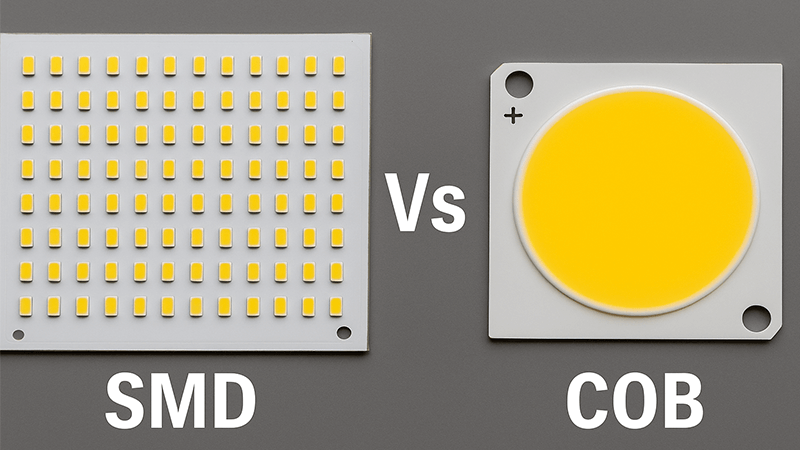
When I started my factory, most LED lights used SMD, or "Surface Mount Device," technology. This means individual LED chips are soldered onto a circuit board. If you look closely at an SMD bulb, you can see the separate points of light. This is fine for general lighting, like a simple ceiling panel. However, for high-performance applications like a museum, SMD has weaknesses. Each individual chip creates its own shadow, resulting in messy, multiple shadows from an object. It also makes it very difficult to design a reflector or lens that can create a clean, sharp beam of light.
Then COB, or "Chip on Board," technology became more advanced. This was a true breakthrough for professional lighting. With COB, hundreds of tiny LED chips are bonded directly onto a substrate and covered with a layer of phosphor. The result is what looks like a single, large light-emitting surface. This single source of light creates a single, crisp shadow, just like the sun or a traditional halogen bulb. This quality is essential for making art look natural.
For a purchasing manager like Shaz, understanding this technical difference is key to sourcing superior products. The benefits of COB for museum and gallery lighting are a direct result of its design.
| Feature | SMD (Surface Mount Device) | COB (Chip on Board) |
|---|---|---|
| Light Source | Multiple, separate points of light | Single, uniform surface of light |
| Beam Control | Difficult; often results in stray light | Excellent; easy to pair with lenses/reflectors for sharp beams |
| Shadow Quality | Multiple, fuzzy shadows | Single, crisp shadow |
| Light Intensity | Lower density | Higher density (more light from a smaller area) |
| Application | General lighting, signs, strips | Spotlights, downlights, high-end accent lighting |
Because COB acts as a single point source, it allows my team of designers to create highly efficient optics that shape the light with incredible precision. This brings us back to my main point: it is this precision that allows us to protect art while making it look stunning.
Conclusion
COB LED downlights and spotlights are the best choice for museums and galleries. They offer precise beam control5, excellent color quality, and artifact protection, creating the perfect viewing experience.
Discover the importance of thoughtful lighting design in preserving and showcasing art. ↩
Explore how proper lighting can safeguard cultural heritage while enhancing visitor experience. ↩
Find out how a layered lighting strategy can balance preservation and presentation in museums. ↩
Explore the advantages of using high CRI LED fixtures for accurate color representation. ↩
Learn about the importance of beam control in preserving art and enhancing visitor experience. ↩
Learn why color temperature is crucial for creating a warm atmosphere in museums. ↩
Learn how accent lighting can highlight specific artworks and enhance visitor engagement. ↩
Explore how COB LED downlights can enhance museum lighting while protecting priceless artifacts. ↩
Discover how ultra-low illuminance can protect sensitive exhibits from light damage. ↩
Explore the benefits of using COB LED strips for uniform illumination in display cases. ↩
Understand how seamless lighting can enhance architectural details without distractions. ↩
Discover how flexible track lighting can adapt to changing exhibitions in galleries. ↩
Explore how COB LED spotlights can enhance the presentation of artwork in galleries. ↩

